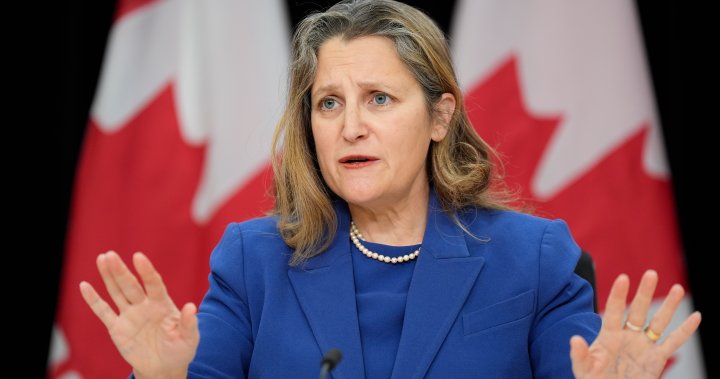Freeland’s Fiscal Tightrope: Navigating Deficit Pledges and Economic Realities
Finance Minister Chrystia Freeland finds herself in a delicate balancing act, attempting to reconcile past deficit reduction promises with the evolving economic landscape. In the 2024 federal budget, Freeland outlined three key fiscal guideposts to demonstrate a responsible economic plan: capping the federal deficit at $40.1 billion, maintaining a declining debt-to-GDP ratio, and ensuring a declining deficit-to-GDP ratio. These guideposts, she argued, would assure credit rating agencies of Canada’s commitment to fiscal prudence. However, recent pronouncements suggest a shift in focus, with Freeland emphasizing the debt-to-GDP ratio as the primary indicator of fiscal sustainability. This subtle shift raises questions about the government’s adherence to its initial deficit cap pledge.
While Freeland previously asserted that all three fiscal markers were being met, her recent responses to questions about the $40.1 billion deficit cap have been notably evasive. Instead of directly addressing whether the government adhered to the cap, Freeland has highlighted the declining debt-to-GDP ratio, arguing that it signifies overall fiscal sustainability. This change in emphasis suggests a potential acknowledgment that the deficit target may have been missed, with the government now prioritizing the broader measure of debt-to-GDP.
Freeland’s emphasis on the debt-to-GDP ratio as the primary fiscal anchor reflects a broader economic strategy. By focusing on the relative size of the debt compared to the overall economy, the government aims to demonstrate its commitment to long-term fiscal health. A declining debt-to-GDP ratio indicates that the economy is growing faster than the debt, which, in theory, allows for greater fiscal flexibility in the future. This approach provides a more nuanced perspective than a fixed deficit cap, acknowledging that economic circumstances can necessitate adjustments in spending and revenue projections.
However, this shift in focus has not gone unnoticed by critics and observers. The parliamentary budget officer, an independent fiscal watchdog, has suggested that the government likely exceeded the $40.1 billion deficit cap. Furthermore, economists have pointed out that spending commitments announced since the budget presentation could further strain Ottawa’s finances. These factors create a challenging backdrop for the upcoming fall economic statement, which is expected to provide a clearer picture of the government’s fiscal position.
The timing of the fall economic statement has also become a point of contention. Its release has been delayed compared to previous years, a delay attributed by Freeland to a Conservative filibuster that has disrupted the usual parliamentary proceedings. This delay adds another layer of complexity to the situation, as it prolongs the uncertainty surrounding the government’s fiscal performance and its ability to meet its stated targets.
In essence, Freeland’s fiscal strategy appears to be evolving in response to changing economic realities. While the initial focus was on a fixed deficit cap, the government now appears to prioritize the broader metric of debt-to-GDP as a more accurate reflection of long-term fiscal sustainability. This shift, while potentially justifiable given the dynamic economic environment, has also opened the government to criticism about transparency and adherence to its initial commitments. The upcoming fall economic statement will be crucial in clarifying the government’s fiscal position and demonstrating its ability to navigate the complex economic landscape.

